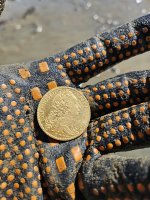Gypsy Heart
Gold Member
PHILIP GILLESPIE, b. February 11, 1817, Henderson County NC; d. January 15, 1864, Maynardsville, Union County TN.
Notes for PHILIP GILLESPIE:
Philip Gillespie, son of Mathew and Elizabeth Sitton Gillespie, was probably the best known of the Gillespie rifle makers of Mills River. Philip was born February 11, 1817, and while a young man, he learned the trade of rifle making from his father, and he learned it well. Many of the Gillespie rifles in existence today bear the inscription P. G. stamped on the barrel of the rifle. Very few of these rifles are to be found today, and when they are, the going price is in the vicinity of $3,000.00. In addition to making rifles, Philip was a farmer, and also operated a distillery. In 1849, Philip purchased 347 acres of property from the estate of Philip Sitton, Sr., who was Philip Gillespie's grandfather. The property included the home of Philip Sitton Sr., and the Iron Forge that Philip Sitton established about 1800.
It was somewhere on this property that Philip Gillispie reportedly buried a cask of brandy and a small sack of gold coins. The next day Philip left Mills River, never to return.
Notes for PHILIP GILLESPIE:
Philip Gillespie, son of Mathew and Elizabeth Sitton Gillespie, was probably the best known of the Gillespie rifle makers of Mills River. Philip was born February 11, 1817, and while a young man, he learned the trade of rifle making from his father, and he learned it well. Many of the Gillespie rifles in existence today bear the inscription P. G. stamped on the barrel of the rifle. Very few of these rifles are to be found today, and when they are, the going price is in the vicinity of $3,000.00. In addition to making rifles, Philip was a farmer, and also operated a distillery. In 1849, Philip purchased 347 acres of property from the estate of Philip Sitton, Sr., who was Philip Gillespie's grandfather. The property included the home of Philip Sitton Sr., and the Iron Forge that Philip Sitton established about 1800.
It was somewhere on this property that Philip Gillispie reportedly buried a cask of brandy and a small sack of gold coins. The next day Philip left Mills River, never to return.



